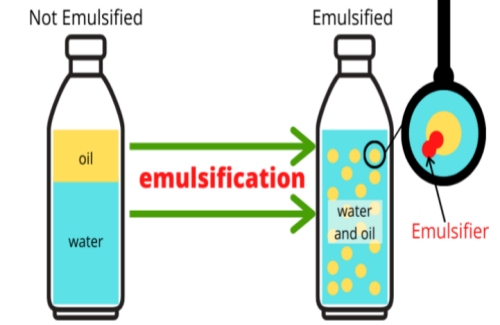Finding the Right Emulsifier In Food for Your Recipes
Why It Is Essential to Incorporate an Emulsifier in Food for Optimum Preference and Quality
Emulsifiers play an essential role in food manufacturing by making certain the stable blending of immiscible fluids, such as oil and water. They minimize interfacial stress, which stops the splitting up of components and adds to an uniform appearance. This not only boosts mouthfeel but likewise influences flavor understanding. Recognizing the need of emulsifiers discloses deeper understandings into their function and importance in culinary applications. What ramifications does this have for food technology and consumer preferences?
Comprehending Emulsifiers: The Basics
Emulsifiers play a necessary duty in food science, functioning as agents that promote the mixing of two immiscible liquids, such as oil and water. These compounds possess both hydrophilic (water-attracting) and hydrophobic (water-repelling) residential or commercial properties, which enable them to stabilize emulsions. Common emulsifiers consist of lecithin, located in egg yolks and soybeans, and mono- and diglycerides, stemmed from fats.
The Science Behind Emulsification
When 2 immiscible liquids are integrated, the process of emulsification ends up being essential for achieving a steady blend. Emulsification entails spreading one fluid within one more, commonly oil in water or the other way around. This procedure takes place via mechanical anxiety, which damages the larger droplets into smaller ones, therefore increasing the surface area. Without the existence of emulsifiers, these droplets would integrate, leading to splitting up.
Emulsifiers are particles with hydrophilic (water-attracting) and hydrophobic (water-repelling) homes. Their one-of-a-kind framework enables them to decrease the interfacial tension between the two immiscible liquids, stabilizing the solution. This stablizing prevents separation and boosts the harmony of structure and flavor. The interactions at the molecular level are essential for keeping the stability of the emulsion, making sure that food maintain their wanted uniformity and taste. Comprehending this scientific research is significant for food researchers and manufacturers in developing high-quality foodstuff.
Sorts Of Emulsifiers Used in Food
The kinds of emulsifiers made use of in food can be extensively classified right into natural and synthetic varieties. Usual food emulsifiers, such as lecithin and mono- and diglycerides, play a crucial duty in improving food stability and structure. Understanding these differences is crucial for valuing how emulsifiers add to the overall top quality of foodstuff.
Synthetic vs. all-natural Emulsifiers
While both natural and synthetic emulsifiers serve the crucial role of stabilizing blends in food products, their attributes and origins vary considerably. All-natural emulsifiers, originated from plant or pet sources, include lecithin, casein, and particular gums. They are commonly perceived as healthier alternatives, attracting customers looking for clean-label products. On the other hand, artificial emulsifiers, such as mono- and diglycerides, are chemically crafted and may offer boosted stability and functionality in a broader series of applications. These synthetic alternatives can be more economical and give consistent quality. Nonetheless, they might stimulate hesitation amongst health-conscious customers. Inevitably, the choice between all-natural and artificial emulsifiers relies on the wanted qualities of the food, including structure, flavor, and shelf-life stability.
Common Food Emulsifiers
Emulsifiers play a vital duty in the food sector, making certain the security and appearance of numerous items. Usual food emulsifiers consist of lecithin, mono- and diglycerides, and polysorbates. Emulsifier In Food. Lecithin, originated from resources like soybeans and egg yolks, is commonly utilized in baked items and delicious chocolates. Mono- and diglycerides, commonly gotten from vegetable oils, improve the creaminess of margarine and gelato. Polysorbates, synthetic emulsifiers, are often found in salad dressings and sauces, advertising a smooth uniformity. Various other emulsifiers such as xanthan gum tissue and guar periodontal, both natural thickeners, also add to the desired appearance in numerous food. Each emulsifier type offers details objectives, adding to the overall quality and allure of food things

Role in Food Security
Food stability is greatly affected by the kinds of emulsifiers used, which aid stop the separation of ingredients in different formulations. Emulsifiers such as lecithin, mono- and diglycerides, and polysorbates play essential functions in maintaining the harmony of products like dressings, sauces, and ice lotions. Lecithin, stemmed from soy or egg yolk, is specifically efficient due to its all-natural homes, while mono- and diglycerides boost texture and service life. Polysorbates, on the other hand, boost the security of oil-in-water solutions, making them optimal for baked goods. The choice of emulsifier depends on the particular food application and wanted characteristics, making certain that products remain steady, appealing, and of excellent quality throughout their designated service life.
Just How Emulsifiers Improve Appearance and Mouthfeel
Enhancing the sensory experience of food, emulsifiers play an essential role in enhancing appearance try here and mouthfeel. These materials promote the consistent distribution of components, permitting a smoother and creamier uniformity in items such as dressings, sauces, and gelato. By supporting combinations of oil and water, emulsifiers prevent splitting up, resulting in a natural texture that improves the overall eating experience.
Furthermore, emulsifiers can customize the viscosity of foodstuff, adding to a desirable thickness or creaminess. This modification of texture can affect how food feels in the mouth, influencing contentment and satisfaction. Additionally, by producing a secure emulsion, emulsifiers aid keep the stability of the item, guaranteeing that the intended mouthfeel is constantly provided gradually. Generally, the application of emulsifiers is crucial for achieving the best texture and mouthfeel, ultimately elevating the top quality of food.
The Role of Emulsifiers in Taste Improvement
Taste enhancement in culinary applications commonly pivots on the efficient use emulsifiers. These substances promote the mixing of water and oil, permitting the even circulation of flavor compounds within food. By producing steady emulsions, emulsifiers assist to envelop and release volatile tastes, improving the total sensory experience.
Additionally, emulsifiers can enhance the understanding of taste by affecting the mouthfeel and structure of dishes. A smoother, a lot more cohesive item can bring about a heightened perception of tastes, making them much more pronounced and delightful. Emulsifiers can protect delicate flavors from destruction, making sure that they remain intact throughout processing and storage space.
Emulsifiers in Popular Food Products
How do emulsifiers add to the texture and security of prominent food items? Emulsifiers play a crucial function in numerous widely eaten products. In salad dressings, they assure a smooth blend of oil and vinegar, stopping splitting up and improving mouthfeel. In gelato, emulsifiers produce a luscious texture by supporting air bubbles, causing an indulgent and abundant item. Baked goods, such as bread and cakes, benefit from emulsifiers by boosting volume and crumb framework, bring about a lighter and more appealing appearance. Furthermore, mayo relies upon emulsifiers to maintain its thick consistency and avoid oil separation. Margarine and spreads likewise make use of emulsifiers to attain a spreadable texture while maintaining stability. These instances highlight the significant influence of emulsifiers on the high quality and enjoyment of daily food, emphasizing their importance in modern food formula.
The Future of Emulsifiers in Food Advancement
The future of emulsifiers in food technology is noted by substantial innovations in technology, leading the means for brand-new formulas. Furthermore, the demand for healthier emulsifier alternatives is rising, motivating scientists to check out natural and plant-based options. Lasting sourcing practices are likewise coming to be crucial, as consumers significantly focus on environmental duty in their food selections.
Improvements in Emulsifier Technology
As scientists proceed to check out the molecular complexities of emulsifiers, significant innovations are arising that assurance to reinvent food development. Recent advancements concentrate on creating extra functional and effective emulsifiers that enhance appearance, stability, and taste in different food. Advancements in biopolymer-based emulsifiers are getting traction, using improved sustainability and efficiency over traditional alternatives. In addition, improvements in nanotechnology are enabling the style of emulsifiers at the molecular level, which can lead to finer solutions and enhanced sensory experiences. These technical breakthroughs are not just boosting product top quality but additionally increasing the series of applications for emulsifiers in the food market. As these developments unravel, they are anticipated to redefine cooking possibilities and customer preferences in why not look here the future.
Healthier Emulsifier Alternatives
While traditional emulsifiers have actually played an essential duty in food production, there is a growing demand for much healthier choices that straighten with consumer choices for all-natural ingredients and clean labels. Innovations in plant-based emulsifiers, such as those stemmed from flaxseed, soy, and sunflower, have actually gained popularity because of their perceived health benefits. These options often include fewer ingredients and supply functionality similar to synthetic emulsifiers. Additionally, components like aquafaba, the fluid from prepared chickpeas, have actually arised as functional emulsifying representatives, interesting vegan and health-conscious consumers. Emulsifier In Food. The shift in the direction of these much healthier emulsifiers not only boosts the allure of food but also supports the trend of transparency in ingredient sourcing, inevitably fostering customer trust fund and complete satisfaction

Lasting Sourcing Practices
Sustainable sourcing techniques are ending up being progressively essential in the advancement of emulsifiers, reflecting a more comprehensive commitment to environmental obligation within the food sector. Makers are now focusing on the use of renewable energies, such as plant-based components, which minimizes the carbon impact related to typical emulsifiers. This shift not just supports biodiversity yet likewise advertises ethical farming practices that profit local areas. Additionally, innovations in modern technology allow the removal and processing of emulsifiers with lowered environmental effect. By taking on lasting sourcing, business improve their brand name image while meeting customer demand for openness and eco-friendliness. As the food sector continues to progress, the integration of lasting emulsifiers will certainly play an essential duty in shaping future advancements, guaranteeing an equilibrium in between quality and environmental stewardship.
Regularly Asked Inquiries
Are Emulsifiers Safe for People With Food Allergies?

Can Emulsifiers Affect the Nutritional Worth of Food?
Emulsifiers can affect the nutritional worth of food by improving vitamins and mineral absorption or possibly changing the bioavailability of specific compounds. Their effects differ widely depending on the kind of emulsifier and the total food solution.
Exactly How Do Emulsifiers Impact Service Life of Products?
Emulsifiers boost the service life of products by maintaining blends, stopping splitting up, and decreasing spoilage. This security assists maintain structure and flavor in time, inevitably making sure food remains enticing and risk-free for longer periods.
What Are Typical Natural Emulsifiers Discovered in Home Kitchens?
Common natural emulsifiers discovered in home cooking areas consist of egg yolks, honey, mustard, and soy lecithin. These active ingredients aid maintain mixtures by lowering surface stress in between oil and water, improving texture and uniformity in various recipes.
Exist Any Problems With Synthetic Emulsifiers in Food?
Problems concerning artificial emulsifiers in view food include prospective digestive concerns, inflammatory feedbacks, and web links to obesity. Some researches recommend these additives may interfere with gut microbiota, increasing inquiries about their lasting effects on health and wellness and health.
Usual food emulsifiers, such as lecithin and mono- and diglycerides, play an important function in enhancing food stability and structure. Emulsifiers play an essential function in the food market, making certain the stability and appearance of different items - Emulsifier In Food. Other emulsifiers such as xanthan gum and guar periodontal, both all-natural thickeners, additionally contribute to the desired structure in numerous food items. Current growths concentrate on creating more efficient and flexible emulsifiers that boost appearance, stability, and flavor in various food products. Emulsifiers can position dangers for people with food allergies, as some emulsifiers are obtained from allergens like soy or eggs